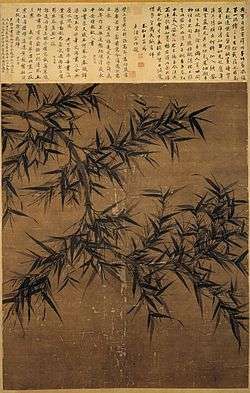Wen Tong

Wen Tong (Chinese: 文同; pinyin: Wén Tóng; Wade–Giles: Wen T'ung) (1019–1079)[1] was a Northern Song painter born in Sichuan[2] famous for his ink bamboo paintings. He was one of the paragons of "scholar's painting" (shi ren hua), which idealised spontaneity and painting without financial reward.
He could hold two brushes in one hand and paint two different distanced bamboos simultaneously. One Chinese idiom in relation to him goes "there are whole bamboos in his heart" (胸有成竹), meaning that one has a well-thought-out plan in his mind.
As did many artists of his era, Wen Tong also wrote poetry. As attested in his poems, he had at least one golden-hair monkey (金丝狨) and a number of pet gibbons, whose graceful brachiation he admired. An elegy written by him upon the death of one of his gibbons has been preserved in the collection of his works.[3]
Notes
- ↑ Barnhart, Page 373. Wen Tong's style name was Yuke (与可) with several sobriquets: Jinjiang Daren(锦江道人), Xiaoxiao Jushi (笑笑居士), and Shishi Xiansheng (石室先生)
- ↑ Ci hai, Page 1533.
- ↑ Robert van Gulik, The gibbon in China. An essay in Chinese animal lore. E.J. Brill, Leiden, Holland. (1967). Pages 77-79. The book includes the original text of Wen Tong's elegy and van Gulik's translation.
References
- Barnhart, R. M. et al. (1997). Three thousand years of Chinese painting. New Haven, Yale University Press. ISBN 0-300-07013-6
- Ci hai bian ji wei yuan hui (辞海编辑委员会). Ci hai (辞海). Shanghai: Shanghai ci shu chu ban she (上海辞书出版社), 1979.